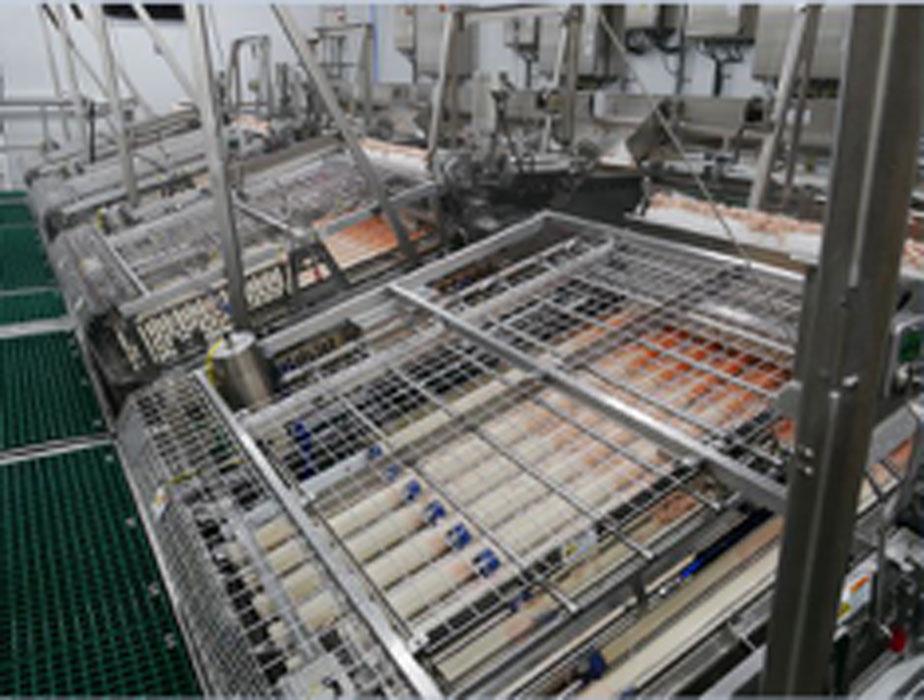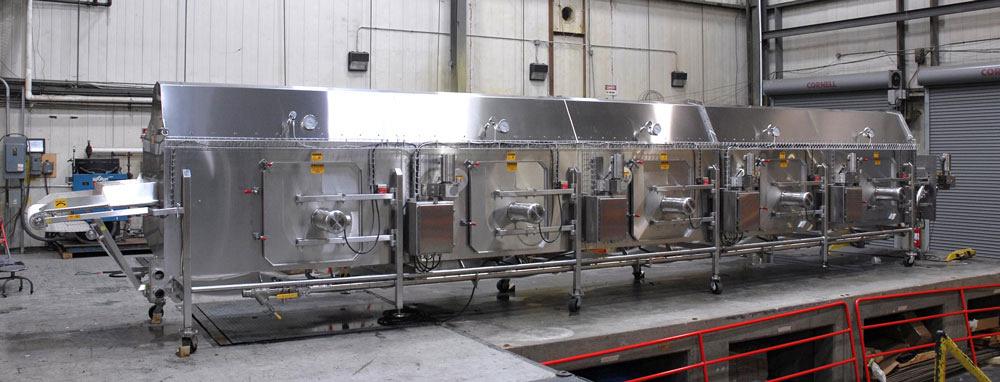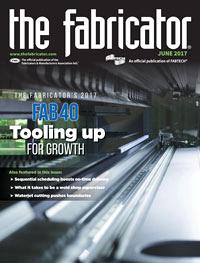Senior Editor
- FMA
- The Fabricator
- FABTECH
- Canadian Metalworking
Categories
- Additive Manufacturing
- Aluminum Welding
- Arc Welding
- Assembly and Joining
- Automation and Robotics
- Bending and Forming
- Consumables
- Cutting and Weld Prep
- Electric Vehicles
- En Español
- Finishing
- Hydroforming
- Laser Cutting
- Laser Welding
- Machining
- Manufacturing Software
- Materials Handling
- Metals/Materials
- Oxyfuel Cutting
- Plasma Cutting
- Power Tools
- Punching and Other Holemaking
- Roll Forming
- Safety
- Sawing
- Shearing
- Shop Management
- Testing and Measuring
- Tube and Pipe Fabrication
- Tube and Pipe Production
- Waterjet Cutting
Industry Directory
Webcasts
Podcasts
FAB 40
Advertise
Subscribe
Account Login
Search
Laitram: An intertwined manufacturer
Coordination ties one diversified Louisiana manufacturer together
- By Tim Heston
- June 5, 2017
- Article
- Shop Management

In action, Laitram Machinery’s shrimp peeling system pinches off the tail while wringing the head and shell through rollers.
Running down the middle of the Laitram Corp. campus in Harahan, La., is Laitram Lane, ending yards away from the Mississippi River, a little west of New Orleans proper. On one side you see an office full of design and manufacturing engineers flanked directly by Laitram Machinery Inc., a stainless steel fabricator that makes shrimp peeling and other food processing equipment.
Across the street is the R&D lab, which is adjacent to Intralox LLC USA. The largest Laitram company, Intralox makes industrial and food-grade conveyors. Intralox’s mold shop has more than 150 injection-molding machines that operate over three shifts. Next to that is Laitram Machine Shop, an internal service center that machines metal and plastic parts. At the end of the lane is Lapeyre Stair, a metal fabricator of alternating tread stairs (ATS) as well as conventional egress stairways, both the fully welded and bolted varieties.
Although Laitram has made its share of acquisitions, the campus isn’t a conglomerate cobbled together by investors. It’s the legacy of company founder James Martial “J.M.” Lapeyre. (Laitram is “Martial” spelled backwards.)
A serial inventor from his teens onward, Lapeyre filed close to 200 patents during his lifetime. One idea led to one invention, which led to the next, which led to the next, which led to Jefferson Parish’s largest manufacturer, with more than 1,000 patents in force throughout the world. About 1,200 people come to work on Laitram Lane every day. Globally it employs close to 2,000 workers.
Business history has plenty of examples of inventors who left a trail of failed businesses in their wake. It’s as if these inventors made gumbo by throwing in the best ingredients (their inventions), yet paid no attention to the roux tying it all together.
Jason Vasseur, production supervisor, planning, for Laitram Machinery, put it best during a tour in March, when the company hosted attendees of The FABRICATOR’s Leadership Summit, part of the Fabricators & Manufacturers Association Annual Meeting. “What makes Laitram unique is that, yes, we have this large campus with different buildings and different companies, but we all intertwine.”
Each Laitram company draws expertise and resources from the others. When this happens effectively, the roux is right.
Through the Wringer
During the summer of 1943, a 16-year-old J.M. Lapeyre worked alongside other peelers at his father’s shrimp peeling plant. He then went home and asked his mother if he could borrow her wringer washing machine, and began experimenting.
Could he pinch and release the shrimp tail meat off while wringing the shell and head through the rollers? He adjusted the rubber roller pressures and, after a year of work, filed his first patent. In 1947 he founded the predecessor to Laitram Machinery, Peelers Inc. Although peelers have advanced significantly since the 1940s, they still use the same “pinch and release” approach.
By the late 1960s J.M. had purchased 5 acres in Harahan, the future home of what would become the Laitram family of companies. And in 1969 he attempted to solve another basic problem for shrimp-peeling customers: Once you peel the shrimp in the peeler, how do you get it to the next operation, be it deveining or anything else? So he invented a modular plastic conveyor that didn’t have the corrosion and sanitation problems of its metal counterparts.
This grew into Intralox, which employs about three-quarters of the Laitram workforce. The division produces not only modular plastic belts, but also thermo-drive belts designed to be easy to clean, as well as plastic belts for complex package handling, sold to the likes of Amazon, UPS, and Fed-Ex. The company also sells spiral belts that convey material vertically, such as those used in baking facilities that need to cool products in a limited space.
An Intertwined Campus
“We don’t have belts sitting on the shelf. Almost every customer conveyor is a different length and width.”
So said Franck LaBiche, Laitram’s human resources director, during a presentation before the tour at the Leadership Summit in March. That statement applied to every operation attendees toured that morning. To build everything to order requires some serious collaboration.
For instance, when walking into the machine shop, attendees saw a plate fixtured in a vertical machining center. The plate edges were being milled to a machining-level tolerance so that the conveyor shaft it holds won’t wobble. That part will be used in conjunction with toothed parts that drive the conveyor.
The toothed parts didn’t come from the machine shop. They were laser-cut at Laitram Machinery. Sure, lasers don’t cut to machining-level tolerances, but they’re faster than machining centers. When used in conjunction with milled plates from the machine shop, the laser-cut parts help drive a conveyor smoothly.
At Lapeyre Stair, attendees witnessed a welder adjusting a telescoping jig holding components for an alternating tread stair (ATS). The jig could be adjusted to any length as well as one of several inclination angles—very steep, since most use an ATS to make climbing easier in tight spaces. The welder had no drawings. He just looked at a few specifications that showed him where to adjust the jig, locked it in place, and started tacking and welding.
“We make [ATSs] in carbon and stainless steel, as well as aluminum, and we make them in any height up to 20 feet, to any fraction of an inch thereof,” said Chuck Selsor, production manager for Lapeyre Stair. “We have a hardware engineer, and we also have resources we use from our sister companies. They’ve all helped us make a lot of tools that streamline our operation.”This help includes not only a jig for welding, but also an automated tube cutoff system that, after a worker scans a bar code attached to a job, adjusts to any length. After a cutoff, the tube is formed on a unique rotary draw bender with a 30-foot bed, long enough to handle the company’s largest stairways.
The only component Lapeyre doesn’t fabricate in-house is the actual tread plates, which are sourced to a local custom stamper. Other than that, raw stock comes in and within hours or a few days, a painted ATS emerges. “And most of that time is for baking in the powder coating process,” Selsor said.
Like its sister organizations, the stair company’s origins go back to one of J.M.’s ideas. This one didn’t come directly from shrimp processing, but instead another fixture of the New Orleans economy: oil rigs. Before J.M. launched his stair company in 1981, rig builders were forced to use narrow stairways designed for ships.

The alternating tread stair (ATS) has treads on only half of the stair width, allowing for installation in tight spaces.
J.M.’s idea: People use only a small cross section of each tread when climbing a stair, so if space is an issue, why have those treads extend all the way across? With the ATS each step extends only halfway across the stair width.
When Selsor joined the company three years ago, the stair fabricator had 18 people running the floor over one shift, “if we were lucky,” he said. “Now I’ve got more than 45 people on the floor running two shifts, and at least some of our equipment is running 24/7.” This includes a 2-D plasma cutting system with a 30-ft. table, long enough to cut the stringers for the company’s longest stair assemblies.
The uptick in business is thanks in part to Lapeyre Stair’s expansion into conventional stairwells. In effect, the company applied its quick-response fabrication for ATS to traditional welded and bolted stairs. During the tour, Selsor pointed to a stair being prepped for shipment. Thanks to a multitude of tabs, slots, and bolts, the entire stair was put together without an ounce of welding wire.
“This also requires no field welding,” Selsor said. “They can install a flight of stairs from one level to another almost as fast as they can take the stairs off the truck.”
Intertwining the Unique
Perhaps nowhere is Laitram’s “roux” more apparent than at Laitram Machinery. With a TRUMPF laser, a Bystronic press brake (and another brake on the way), deburring equipment, and welding cells, the place looks a lot like any custom fabricator—until you look a little closer at the work that’s flowing through the shop.
Leading a group tour during the Leadership Summit, Vasseur began by describing just how many different jobs the shop manages. “Our core business is shrimp processing equipment. We also have applications in nut pasteurizing, vegetable blanching, as well as crab and lobster processing. We have Intralox belts incorporated into our equipment. And we incorporate catwalk systems, stairs, and handrails fabricated by Lapeyre Stair. Laitram Machine Shop, which is right across the street, is our No. 1 supplier. We also do a lot of one-off work for Intralox R&D. And we do a lot of turnkey assemblies that are dropped in during final conveyor assembly.”
As the shop’s chief planner, how does Vasseur schedule all the fabrications necessary and make sure they all get where they’re supposed to be? Vasseur paused and smiled. “Very carefully.”
Many of the food processing machines use common components, like blowers. When the schedule allows, Vasseur batches parts for several dozen blowers together. But other than that, the shop really can’t build ahead until an order is triggered. Almost every piece of equipment is built to order.
Vasseur schedules by the constraint, usually welding, then builds in buffers to account for the unexpected, such as the expedited jobs fabricators are all too familiar with. For instance, if a customer (internal or external) needs a part to repair a machine, especially if the customer is down, Vasseur switches gears and bumps those repair parts to the front of the line to help the service team get those customers back up and running as quickly as possible.
On its own, Laitram Machinery is essentially a very high-product-mix, vertically integrated precision metal fabricator. When practical, all parts needed for an assembly travel as a kit. Piece parts then go to deburring and bending. Near the press brake is an area where “buckets” of parts are staged for assembling and joining. Each bucket is filled with every part welders need for a subassembly. Being a stainless shop, Laitram Machinery predominantly uses gas tungsten arc welding.

A seafood steam cooker at Laitram Machinery incorporates parts from Laitram Machine Shop as well as conveyors from Intralox.
The bucket area determines the flow of the entire shop. Welders retrieve a complete bucket, which in turn pulls more work from upstream, which populates the dispatch list for the laser cutting and brake operators.
Welders set up fixtures and then prep, weld, and passivate parts before they head to a designated bay for final assembly. (During the tour, a 30-ft.-long seafood steam cooker sat ready for final inspection.) Around each assembly bay are color-coded staging areas signifying different kinds of parts: one for laser-cut only, one for formed parts, another for subassemblies, etc.
During the tour, Vasseur showed an area that you wouldn’t find in a typical custom fabricator, one lined with vertical rubber rollers destined for high-speed conveyors used in the packaging industry. This year Laitram moved some of its overflow production of one of its Intralox conveyors from a plant in Savage, Md., which ran out of space, to the Harahan campus. As part of that project, Laitram Machinery is setting up a lean assembly cell, putting together machined metal and plastic parts from Laitram Machine Shop, rollers and plastic-injection-molded parts from Intralox, as well as sheet metal parts from Laitram Machinery.
The Maryland operation could have outsourced the overflow work, but that would have brought up complications regarding intellectual property. “So now we’re building these [conveyor projects] as turnkey systems,” Vasseur said. “Intralox doesn’t have to worry about IP getting out. And we’ve got engineers right across the street. If we ever have an issue, they can be here in 10 minutes.”
The Roux
Communication is a central factor in any vertical integration. A fabricator can buy a machine shop, but if people still operate in their own silos, they’re not getting the most out of the merger.
The same holds true on Laitram Lane. Intralox engineers walking across the lane to visit Laitram Machinery’s laser, press brake, or assembly cells; the machining of fixtures at Laitram Machine Shop for Lapeyre Stair; the sharing of products, resources, and knowledge—all of it makes the roux that holds a group of disparate organizations together.Photos courtesy of Laitram Corp., 504-733-6000, www.laitram.com
About the Author

Tim Heston
2135 Point Blvd
Elgin, IL 60123
815-381-1314
Tim Heston, The Fabricator's senior editor, has covered the metal fabrication industry since 1998, starting his career at the American Welding Society's Welding Journal. Since then he has covered the full range of metal fabrication processes, from stamping, bending, and cutting to grinding and polishing. He joined The Fabricator's staff in October 2007.
Related Companies
subscribe now

The Fabricator is North America's leading magazine for the metal forming and fabricating industry. The magazine delivers the news, technical articles, and case histories that enable fabricators to do their jobs more efficiently. The Fabricator has served the industry since 1970.
start your free subscription- Stay connected from anywhere

Easily access valuable industry resources now with full access to the digital edition of The Fabricator.

Easily access valuable industry resources now with full access to the digital edition of The Welder.

Easily access valuable industry resources now with full access to the digital edition of The Tube and Pipe Journal.
- Podcasting
- Podcast:
- The Fabricator Podcast
- Published:
- 04/16/2024
- Running Time:
- 63:29
In this episode of The Fabricator Podcast, Caleb Chamberlain, co-founder and CEO of OSH Cut, discusses his company’s...
- Industry Events
16th Annual Safety Conference
- April 30 - May 1, 2024
- Elgin,
Pipe and Tube Conference
- May 21 - 22, 2024
- Omaha, NE
World-Class Roll Forming Workshop
- June 5 - 6, 2024
- Louisville, KY
Advanced Laser Application Workshop
- June 25 - 27, 2024
- Novi, MI

































